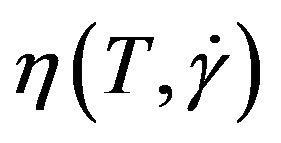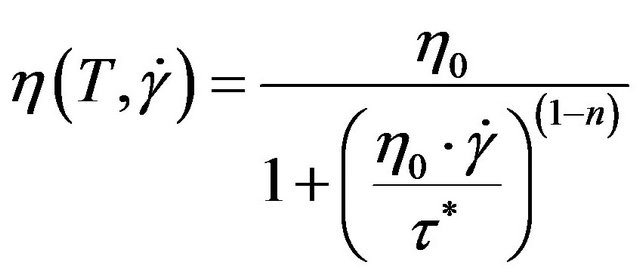Simulation and Injection Molding of Ring-Shaped Polymer Bonded Nickel Braze Metal Composite Preforms Based on Rheological and Thermal Analyses ()
1. Introduction
Polymer-particle composites attract great attention in scientific research and industrial applications, e.g. in electrical, magnetic or thermal devices and processes [1-6]. The functional properties of composites are custom-made adjustable by combining polymers and particles having optimized property profile and volume fraction in the composite [6]. The main advantage of polymer-particle composites is their easy and cost efficient process ability in injection molding even in case of complex structures. Hence, conventional materials and processes are substitutable, e.g. by injection molding of polymer bonded nickel based braze metal performs for high temperature brazing processes [6].
The flow behavior of polymer-particle composite melts is significantly affected by their particle content, which affects the process ability in melt processing [7]. The simulation of flow behavior of particle reinforced composites is a current research topic in polymer processing and complex fluid dynamics. However, the particle-particle and polymer-particle interactions in composites cannot be adequate reproduced in process simulation up to now. For industrial applications in automotive and electronic sector the macroscopic flow behavior of composites is the main driving force to produce complex functional high-end products by injection molding. Simulation software Autodesk® Moldflow® is designed to determine the processing behavior of polymers and polymer bonded composites in flow processes. Therefore, multi-phase materials have to be reduced to a continuous single-phase material. Nevertheless, homogeneous distribution of particles (or fibers) in injection molded composite parts is mandatory for uniform material behavior.
Material properties (e.g. viscosity, pvt-behavior, thermal conductivity, specific heat capacity) of standard thermoplastic polymers are usually available from material database provided by the simulation software. In case of custom-made polymer-particle composites these properties are not included in standard databases. Thus, rheological and thermal properties of polymer bonded braze metal composites have to be analyzed and fitted to provide a material-specific database for simulation and injection molding of composite preforms, which has not been published in literature up to now.
In the last decades a large number of phenomenological and empirical models were established to describe the flow behavior of polymer melts. Based on the well-known Carreau model [8,9] the Cross-WLF equation was found by Williams et al. [10] to describe the temperature and shear rate dependent viscosity  of polymer melts [11]:
of polymer melts [11]:
 (1)
(1)
with
 (2)
(2)
The zero shear viscosity η0 describes the Newtonian plateau in which the viscosity approaches a constant at very low shear rates. Furthermore,  is the shear rate,
is the shear rate,  is the critical stress level at the transition to shear thinning, n is the power law index in the high shear rate regime, D1, A1 and A2 are data-fitted coefficients and D2 is the glass transition temperature.
is the critical stress level at the transition to shear thinning, n is the power law index in the high shear rate regime, D1, A1 and A2 are data-fitted coefficients and D2 is the glass transition temperature.
The pressure-volume-temperature (pvt) behavior of amorphous polymers was modeled and experimental investigated by Chang et al. [12]. The 2-domain Tait-pvt model is used to account the material compressibility during a flow simulation. The specific volume  is a function of temperature T and pressure p described for semi-crystalline polymers as follows:
is a function of temperature T and pressure p described for semi-crystalline polymers as follows:
 (3)
(3)
At temperatures above transition temperature  Equation (3) can be written as:
Equation (3) can be written as:
 (4)
(4)
At temperatures below transition temperature  Equation (3) is given as:
Equation (3) is given as:
 (5)
(5)
with
 (6)
(6)
The physical meaning of the parameters used in Equations (4)-(6) is described in Table 1.
2. Materials and Methods
Low density Polyethylene (LD-PE, Lupolen 1806 H, Lyondellbasell, Ludwigshafen, Germany) with a specific density of 0.919 g/cm3 was chosen as semi-crystalline thermoplastic polymer matrix.
Spherical nickel (Ni) braze metal powder (B-Ni82- CrSiBFe970/1000, Womet GmbH, Willich, Germany) with typical particle size distribution from 10 µm to 106 µm (see Figure 1) and specific density of 7.7 g/cm3 was selected as filler particles. Figure 1 shows sum allocation

Figure 1. Particle size distribution of braze metal particles.
Table 1. Physical meaning of the parameters used in the 2- domain Tait-pvt model [12].

and mono-modal density allocation of Ni braze metal powder.
LD-PE and pre-heated (100˚C) braze metal microparticles were compounded for 10 min at 200˚C and 50 rpm in a co-rotating lab kneader (PolyLab Rheomix 600 p, ThermoHaake, Thermo Fisher Scientific, Karlsruhe, Germany) to LD-PE + 65 vol% Ni composite. LD-PE and Ni particles were dosed gravimetrically using a laboratory balance (Aculab Arilon, Sartorius GmbH, Göttingen, Germany).
Viscosity, pvt-behavior (p = pressure, v = specific volume, T = temperature) and thermal conductivity of LDPE and LD-PE + 65 vol% Ni were characterized using high shear capillary rheometer (Rheograph 75, Goettfert Werkstoff-Pruefmaschinen GmbH, Germany). Viscosity was determined from apparent viscosity using Bagleyand Rabinowitsch-Weissenberg corrections. Pvt-behavior and thermal conductivity were analyzed in script-controlled methods. Specific heat capacity was analyzed by modulated differential scanning calorimeter (MDSC Q2000, TA Instruments, Alzenau, Germany) in temperature range between 20˚C and 200˚C with heating rate of 3˚C/min and temperature modulation of 0.48˚C/min under nitrogen atmosphere. For temperature calibration the melt temperature of indium, lead, tin and zinc standards have been measured to achieve a minimum temperature deviation of 0.2˚C. Autodesk® Moldflow® (Insight) and OriginLab® (OriginPro8G) software were used to perform simulation and data fitting. The composite was granulated and further injection molded in multi-cavity tool to ring-shaped braze metal preforms (44 mm inner diameter with 3 mm diameter in cross section, 10 mm inner diameter with 2 mm diameter in cross section) using a hydraulic injection molding machine (Arburg Allrounder 220S, Arburg, Lossburg, Germany).
3. Results and Discussion
Figure 2 shows the shear viscosity of LD-PE and LD-PE + 65 vol% Ni composite at shear rate ranging from 11 to 5 × 104 (1/s) and three different temperatures (180˚C, 200˚C, 220˚C). The typical shear-thinning viscosity behavior of LD-PE increases significantly by adding 65 vol% braze metal particles. Viscosity of the composite is up to four times higher than that of LD-PE, which consequently reduces flow ability in melt processing. Furthermore, viscosity of LD-PE and LD-PE + 65 vol% Ni composite was shifted to lower values with increasing temperature. Similar behavior was measured on complex viscosity of PP/FeSi composites at filler content up to 70 vol% [7]. In general, processing temperature is limited by thermal degradation of the polymer matrix.
The viscosity behavior of LD-PE and LD-PE + 65 vol% Ni composite in Figure 2 was fitted using CrossWLF equation, mentioned in Equations (1) and (2).
The parameter of the Cross-WLF equation were determined by OriginLab® software and are mentioned in Table 2 for LD-PE and LD-PE + 65 vol% Ni composite. The accuracy of the viscosity fitting was 99.99%.
Figure 3 shows pvt (p = pressure, v = specific volume, t = temperature) behavior of LD-PE and LD-PE + 65 vol% Ni composite. Specific volume of LD-PE decreases with increasing pressure and decreasing temperature. In melt temperature range of LD-PE (approx. 110˚C) the pvt-behavior of LD-PE is characterized by declining specific volume compared to LD-PE + 65 vol% Ni composite (cf. Figure 3), caused by the shrinkage of LD-PE while cooling from molten to solid state. Increasing filler content of rigid braze particles in composite reduces specific volume up to 6.5 times. The maximum variation in specific volume of LD-PE is 263 mm3/g, whereas LD-PE + 65 vol% Ni composite shows a maximum specific volume range of 14 mm3/g. Consequently, shrinkage of LDPE + 65 vol% Ni composite is approximately 5% of LDPE, whereby replication quality of injection molded composite structures is improved by adding rigid braze metal particles. Since, specific density is defined as the inverse